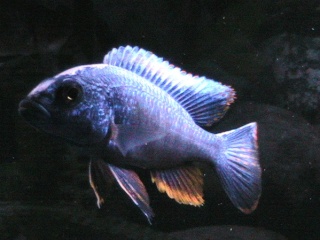Electric Blue HapCommon Name(s): Electric Blue, Electric Blue Hap
Scientific Name: Sciaenochromis fryeri
Origin(s): Lake Malawi (Africa)
Life span: 10+ years
Mature Adult Size: 5-7 inches with males getting a bit larger
Breeding: Mouth Brooder
Temperament: Mildly Aggressive
pH: 7.5-8.5 A hardness of 7-8dh should be maintained ( A stable ph and hardness is more inportant and a wide range will be tolerated.
Temperature: 74-80 degrees feirenhight
Diet: Omnivorous, In captivity this fish does well on a variety of foods including assorted freeze dried foods, beef heart, blood worms, brine shrimp, commercial Cichlid pellets and flakes, daphnia, frozen plankton, glass worms, live fish and tubifex worms.
Minimum Tank Size: 55g will be a good starting point
Tank Region: Mainly bottom dwelling fish.
Information:The Electric Blue is one of the most beautiful of all the Lake Malawi Cichlids. Though they are well known for their brilliant blue coloring, females tend to be a silver or brown color. The bright blue coloration for which this fish is famous, is only seen in males. The average mature Electric Blue will measure between 6 and 7 inches in length, the Electric Blue is native only to Lake Malawi in Africa. Historically, this fish was classified in the genus "Haplochromis" and the species "ahli". In recent years that has changed, with the current genus and species as Sciaenochromis fryeri. The Electric Blue Cichlid is a striking addition to any tank. It is a well known and common species amongst aquaraists. The bright blue (hence electric) coloration of the males and relatively large size along with ease of care has gained them the respect as one of the most commonly kept Cichlid species.
Filtration and Setup:Vigorous filtration must be combined with regular water changes. With powerful filtration, a 30%-50% water change per week can be enough, provided that you avoid over feeding. Low stocking density will reduce the risk of high levels of nitrogenous waste. Rock caves should be provided for females to hide from males after spawning. Driftwood and live plants can be used as well.
Ideally the volume of the water in the tank should be turned over 10 times per hour (through bacteria harboring media) when using filters such as 'hang on the back's', 'pre-filtered powerheads' or 'air-powered filters'.
When using more advanced filters such as 'canisters', 'wet /dry’s' or 'strait sumps' this turn over rate can be reduced to 4-5 times per hour provided the filter holds enough media.
The Sciaenochromis fryeri will enjoy a lot of rock work and caves. They will move sand or gravel to dig their pits and create their own territory. Although they enjoy higher protein foods they will also enjoy eating plant matter. Only robust plants such as jave ferns and like plants should be used. As plants actively take up nitrogen this is another reason as to the role of live plants in a cichlid aquarium.
Tank Mates:Tank mates should include other mild mannered Malawi Mbuna and Haps. the fryeri is mildly aggressive compared to other sililar species and will not do good with more aggressive species. Similar colored fish should be avoided.
Breeding:The Electric Blue Cichlid is a mouth brooder as with most lake Malawi Cichlids. It is generally recommended that the male be placed in a breeding tank with several females A recommended ratio is 3-4 females to one Male. During spawning the Electric Blue may become quite territorial and aggressive the process is very educational and very fun to watch if you can catch them in action. This fish will often breed in caves or hides with the male attracting the ovulating female to his nest whereby ovulation and fertilization of the eggs takes place. The female with then begin to collect the eggs in her mouth where they are held for hatching. This is the reasoning as for the "egg spot" on many Cichlid anal fins, as the female collects the eggs and attempts to grab the egg spot fertilization is assured. After breeding the female keeps the fry in her mouth for three to four weeks The eggs will hatch usually 7 days there after. Fry should be fed brine shrimp initially and may begin feeding on ground commercial foods within a week or so. Stripping the female of the fry may be necessary and can be done safely around ten days after they hatch. This process can be hard on the fish and should only be done by the more experienced fish keeper.









